
The papaya, papaw, or pawpaw is the plant Carica papaya, one of the 22 accepted species in the genus Carica of the family Caricaceae. It was first domesticated in Mesoamerica, within modern-day southern Mexico and Central America. In 2020, India produced 43% of the world supply of papayas.

Melicoccus bijugatus is a fruit-bearing tree in the soapberry family Sapindaceae, native or naturalized across the New World tropics including South and Central America, and parts of the Caribbean. Its stone-bearing fruits are edible. It is also called Bajan ackee, genip, guinep, genipe, ginepa, kenèp, quenepa, quenepe, quenette, chenet, skinup, talpa jocote, mamón, limoncillo, canepa, skinip, kenepa, kinnip, huaya, or mamoncillo.
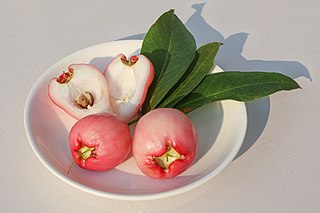
Syzygium samarangense is a species of flowering plant in the family Myrtaceae, native to an area that includes the Greater Sunda Islands, Malay Peninsula and the Andaman and Nicobar Islands, but introduced in prehistoric times to a wider area and now widely cultivated in the tropics. Common names in English include wax apple, Java apple, Semarang rose-apple and wax jambu.

Coccoloba uvifera is a species of flowering plant in the buckwheat family, Polygonaceae, that is native to coastal beaches throughout tropical America and the Caribbean, including southern Florida, the Bahamas, the Greater and Lesser Antilles, and Bermuda. Common names include seagrape and baygrape.
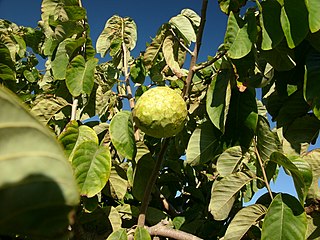
The cherimoya, also spelled chirimoya and called chirimuya by the Inca people, is a species of edible fruit-bearing plant in the genus Annona, from the family Annonaceae, which includes the closely related sweetsop and soursop. The plant has long been believed to be native to Ecuador and Peru, with cultivation practiced in the Andes and Central America, although a recent hypothesis postulates Central America as the origin instead, because many of the plant's wild relatives occur in this area.

Chrysophyllum cainito is a tropical tree of the family Sapotaceae. It is native to the Isthmus of Panama, where it was domesticated. It has spread to the Greater Antilles and the West Indies and is now grown throughout the tropics, including Southeast Asia. It grows rapidly and reaches 20 meters in height.

Chrysophyllum is a group of trees in the Sapotaceae described as a genus by Linnaeus in 1753.

Conocarpus erectus, commonly called buttonwood or button mangrove, is a mangrove shrub in the family Combretaceae. This species grows on shorelines in tropical and subtropical regions around the world.

Mammea americana, commonly known as mammee, mammee apple, mamey, mamey apple, Santo Domingo apricot, tropical apricot, or South American apricot, is an evergreen tree of the family Calophyllaceae, whose fruit is edible. It has also been classified as belonging to the family Guttiferae Juss. (1789), which would make it a relative of the mangosteen.

Syzygium cumini, commonly known as Malabar plum, Java plum, black plum, jamun, jaman, jambul, or jambolan, is an evergreen tropical tree in the flowering plant family Myrtaceae, and favored for its fruit, timber, and ornamental value. It is native to the Indian subcontinent, adjoining regions of Southeast Asia, including Myanmar, Sri Lanka, and the Andaman Islands. It can reach heights of up to 30 metres (98 ft) and can live more than 100 years. A rapidly growing plant, it is considered an invasive species in many world regions.

Spondias purpura is a species of flowering plant in the cashew family, Anacardiaceae, that is native to tropical regions of the Americas, from Mexico to Brazil. It is also very common in most of the Caribbean islands. It is commonly known as jocote, which derives from the Nahuatl word xocotl, meaning any kind of sour or acidic fruit. Other common names include red mombin, plum, purple mombin, hog plum, ciriguela, ceriguela, seriguela, siriguela (Brazil) cocota, ciruela huesito (Colombia), ciruela, ciruela traqueadora (Panama), ciriguela, cirigüela, cirguela, cirguelo (Ecuador), makapruim, and siniguelas (Philippines). It is a popular fruit throughout Central America, particularly in El Salvador, Nicaragua, Honduras and in Costa Rica.
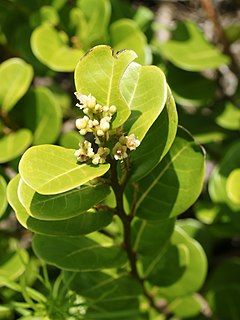
Chrysobalanus icaco, the cocoplum, paradise plum, abajeru or icaco, is a low shrub or bushy tree found near sea beaches and inland throughout tropical Africa, tropical Americas and the Caribbean, and in southern Florida and the Bahamas. An evergreen, it is also found as an exotic species on other tropical islands, where it has become a problematic invasive. Although taxonomists disagree on whether Chrysobalanus icaco has multiple subspecies or varieties, it is recognized as having two ecotypes, described as an inland, much less salt-tolerant, and more upright C. icaco var. pellocarpus and a coastal C. icaco var. icaco. Both the ripe fruit of C. icaco, and the seed inside the ridged shell it contains, are considered edible.

Pouteria caimito, the abiu, is a tropical fruit tree originated in the Amazonian region of South America. It grows to an average of 10 metres (33 ft) high, and can grow as high as 35 metres (115 ft) under good conditions. Its fruits' shape varies from round to oval, pointed at the distal end. When ripe, it has smooth, bright yellow skin and has one to four ovate seeds. The inside of the fruit is translucent and white. It has a creamy and jelly-like texture and its taste is similar to the sapodilla — a sweet caramel custard. The abiu tree is part of the family Sapotaceae and is very similar in appearance to the canistel.
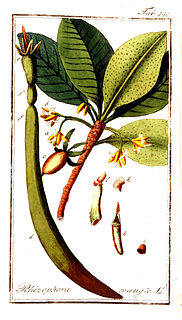
Rhizophora mangle, the red mangrove, is distributed in estuarine ecosystems throughout the tropics. Its viviparous "seeds", in actuality called propagules, become fully mature plants before dropping off the parent tree. These are dispersed by water until eventually embedding in the shallows.

Diospyros nigra, the black sapote, is a species of persimmon. Common names include chocolate pudding fruit, black soapapple and zapote prieto. The tropical fruit tree is native to Mexico, Central America, and Colombia. The common name sapote refers to any soft, edible fruit. Black sapote is not related to white sapote nor mamey sapote.

Syzygium jambos is a species of rose apple originating in Southeast Asia and occurring widely elsewhere, having been introduced as an ornamental and fruit tree.
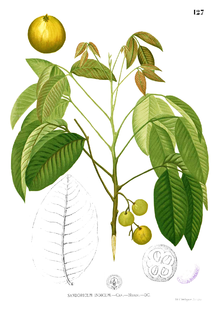
Sandoricum koetjape, the santol, sentul or cotton fruit, is a tropical fruit native to maritime Southeast Asia (Malesia).

Syzygium malaccense is a species of flowering tree native to tropical Asia and Australia. It is one of the species cultivated since prehistoric times by the Austronesian peoples. They were carried and introduced deliberately to Remote Oceania as canoe plants. In modern times, it has been introduced throughout the tropics, including many Caribbean countries and territories.

Piscidia piscipula, commonly named Florida fishpoison tree, Jamaican dogwood, or fishfuddle, is a medium-sized, deciduous, tropical tree native to the Greater Antilles, extreme southern Florida and the Bahamas, and the coastal region from Panama northward to the vicinity of Ocampo, Tamaulipas, Mexico. The native Taino of the West Indies discovered extracts from the tree could sedate fish, allowing them to be caught by hand. This practice led to the tree's common names—fishpoison and fishfuddle. The tree has medicinal value as an analgesic and sedative.

Artocarpus camansi, the breadnut, is a species of medium-sized tree in the family Moraceae. It is native to New Guinea, the Maluku Islands, and the Philippines. It is the wild ancestor of the breadfruit (Artocarpus altilis) and is also sometimes known as the seeded breadfruit, to distinguish it from its mostly seedless descendant. Breadnut fruits are edible when cooked. The large seeds can also be roasted and eaten.























